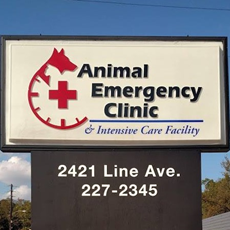Library
-
Osteochondrosis (OCD) is a failure of the bone underlying the smooth articular cartilage inside the joints, i.e. the subchondral bone, to form properly from the skeleton's cartilage template.
-
Osteosarcomas are somewhat rare in cats and progress slowly. Osteosarcoma is very painful. The most common location where osteosarcomas develop in cats is the hindlimb. Amputation is by far the most common treatment. Chemotherapy is not generally pursued without evidence of metastasis, given the relatively long-term control with surgery alone.
-
Osteosarcoma, or bone cancer, is common in large breed dogs and is very aggressive, with upwards of 90-95% of patients having micrometastasis. Osteosarcoma is very painful. Lameness or a distinct swelling may be noted. Amputation is by far the most common treatment with chemotherapy following surgery. Radiation therapy may also be an option.
-
Nobody has ever accused the Otterhound of primping and preening. She is a come-as-you-are kind of dog, with casual good looks and a laid-back personality.
-
Rarely, ovarian tissue can be left behind when a dog is spayed. This leads to the ongoing secretion of hormones such as estrogen and progesterone that can result in a dog continuing to have a heat cycle. Ovarian remnants are difficult to diagnose, but vaginal cytology combined with hormone testing can be used to confirm the presence of functional ovarian tissue. Surgical treatment is typically recommended to prevent other health conditions from developing.
-
Ovarian tumors are quite rare in North American pets, mainly due to routine spaying practices. This handout discusses ovarian tumors in dogs and cats. The various forms of ovarian tumors, clinical signs, diagnosis, treatment, and prognosis of this cancer are outlined.
-
Ferrets are generally good-natured, inquisitive, playful animals that enjoy the company of humans. They can make great pets! This handout provides some basic facts about ferrets and what you need to know about keeping one as a pet.
-
Gerbils generally make good family pets but should never be left unsupervised with small children. If well-socialized from a young age and treated gently, they can be wonderful pets. The incisors (front teeth) of all rodents grow continuously throughout the animal's life. Gerbils do not require vaccines, but they should have annual examinations.
-
If well socialized from a young age and treated gently, hamsters are generally slow moving, reasonably easy to handle, and affectionate. Hamsters make good family pets but should never be left unsupervised with small children. Hamsters should have annual physical examinations and fecal tests for intestinal parasites.
-
Prairie dogs (most often black-tailed prairie dogs) are becoming popular as pets. Like all rodents, they have teeth that continually grow throughout life. They are active, playful and sturdy rodents and can make wonderful, affectionate pets if purchased young, socialized properly and given lots of attention.




